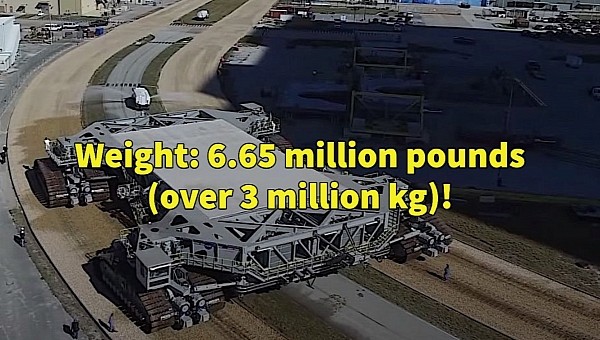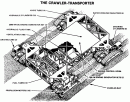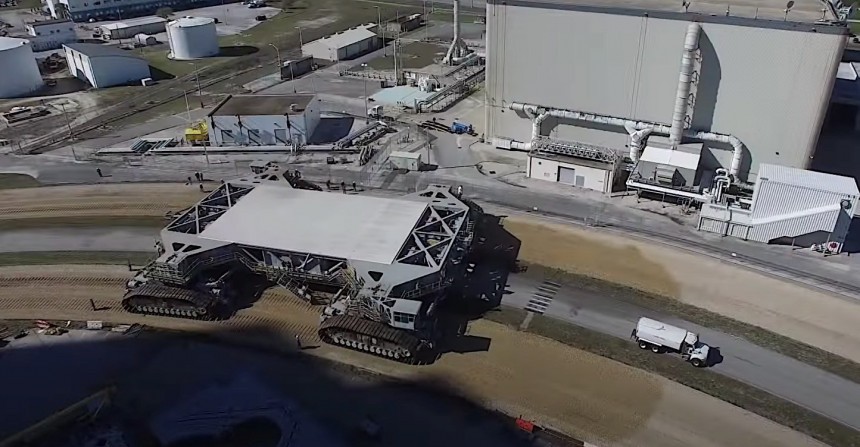The high-speed journeys our space rockets take to wherever they’re going always begin with a very slow crawl from the place where they are assembled to the launch pad. For NASA rockets, the last trip they take on this Earth is done with the help of something called Crawler Transporter 2. And the thing is now the holder of an official Guinness World Records certificate.
The huge machine is part of a family NASA used to call Missile Crawler Transporter Facilities. This breed came about back in the 1960s when all the other wonders of the American space exploration program were born.
Over the years, crawlers have been used by the space agency to transport rockets to the launch pad for the Apollo program, and the Space Shuttles that followed, and now they are tasked with moving the huge Space Launch System rockets of the Artemis program to Launch Pad 39B.
The Crawler Transporter 2, the current iteration of the massive machine, comes as a series of independent tracks that ride underneath a platform larger than a baseball infield. The tracks are powered by two 2,220 horsepower Cummins engines, but also massive electrical power generators to feed no less than 16 traction motors, each capable of developing 375 hp.
Each of the tracks meets the platform above at four points, arranged in a 90-foot (27 meters) square. Overall, the structure is 131 feet long and 114 feet wide (40 meters long and 35 meters), and uses a hydraulic system that allows it to have a variable height of between 20 feet and 26 feet (6 to 8 meters).
All of the above numbers are impressive, but the crawler has another thing going for it: weight. Tipping the scales at 6.65 million pounds (over three million kg, or 3,335 tons, and that is the equivalent of about 1,000 pickup trucks), it is one heavy beast. Well, not just a heavy beast, but the world’s heaviest self-powered vehicle, as per the Guinness World Records title the machine received earlier this week.
The crawler’s innate weight, combined with the weight of the SLS rocket it’s supposed to carry to the launch pad, makes it a very slow-moving machine – after all, it’s not called a crawler for nothing.
At its fastest, the transporter can cover the 4.2 miles (6.7 km) distance that separates the Vehicle Assembly Building from the launch pad in about eight hours, but the trip can take even as much as 12 hours depending on conditions. The average speed of the thing rarely exceeds one mile per hour (0,3 kph).
We'll get to see the transporter in action again next year, when it will move the SLS and Orion of the Artemis II crewed mission to its designated departure point.
Over the years, crawlers have been used by the space agency to transport rockets to the launch pad for the Apollo program, and the Space Shuttles that followed, and now they are tasked with moving the huge Space Launch System rockets of the Artemis program to Launch Pad 39B.
The Crawler Transporter 2, the current iteration of the massive machine, comes as a series of independent tracks that ride underneath a platform larger than a baseball infield. The tracks are powered by two 2,220 horsepower Cummins engines, but also massive electrical power generators to feed no less than 16 traction motors, each capable of developing 375 hp.
Each of the tracks meets the platform above at four points, arranged in a 90-foot (27 meters) square. Overall, the structure is 131 feet long and 114 feet wide (40 meters long and 35 meters), and uses a hydraulic system that allows it to have a variable height of between 20 feet and 26 feet (6 to 8 meters).
The crawler’s innate weight, combined with the weight of the SLS rocket it’s supposed to carry to the launch pad, makes it a very slow-moving machine – after all, it’s not called a crawler for nothing.
At its fastest, the transporter can cover the 4.2 miles (6.7 km) distance that separates the Vehicle Assembly Building from the launch pad in about eight hours, but the trip can take even as much as 12 hours depending on conditions. The average speed of the thing rarely exceeds one mile per hour (0,3 kph).
We'll get to see the transporter in action again next year, when it will move the SLS and Orion of the Artemis II crewed mission to its designated departure point.













